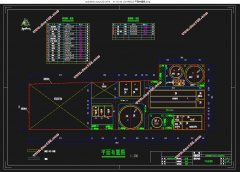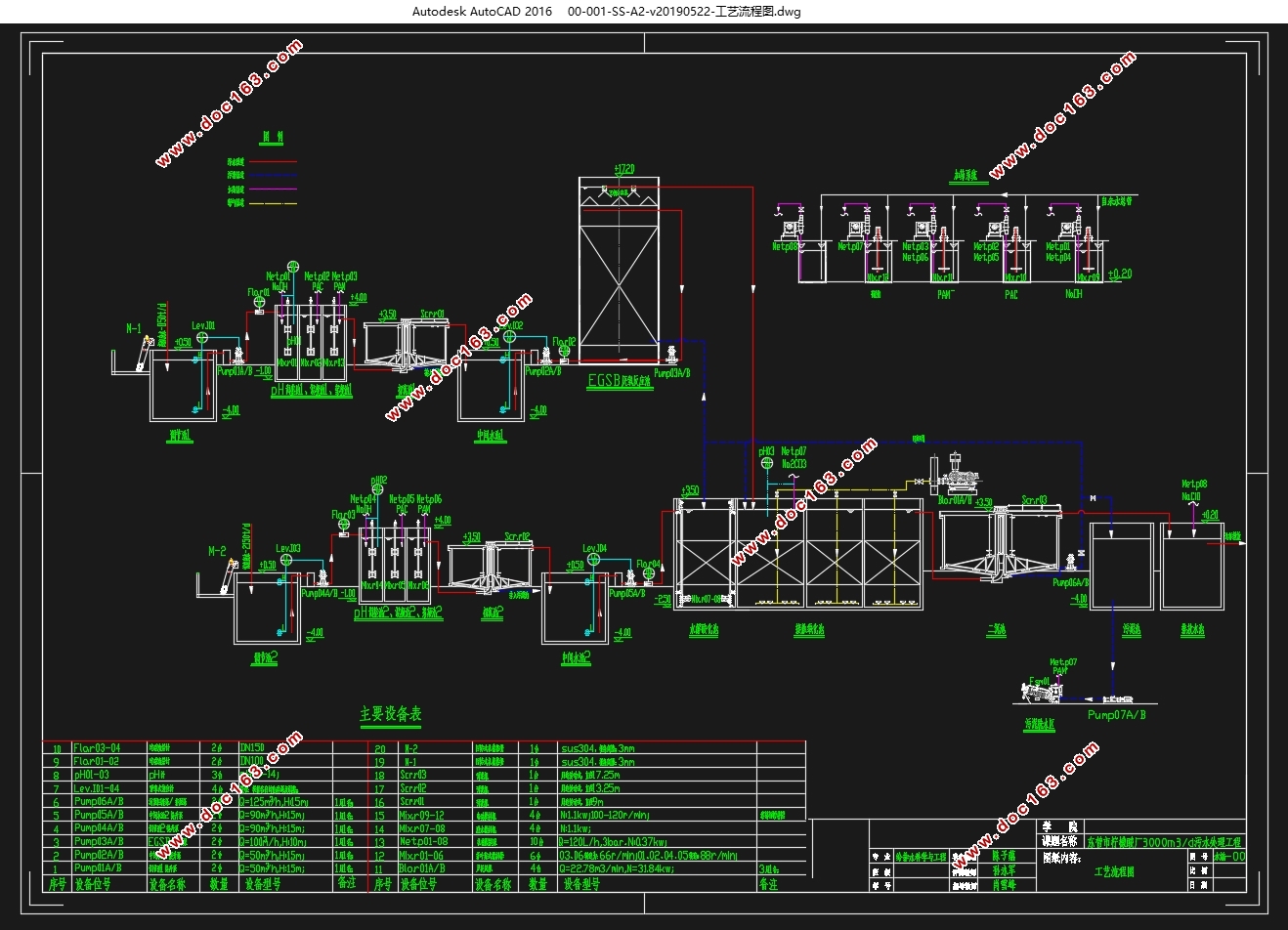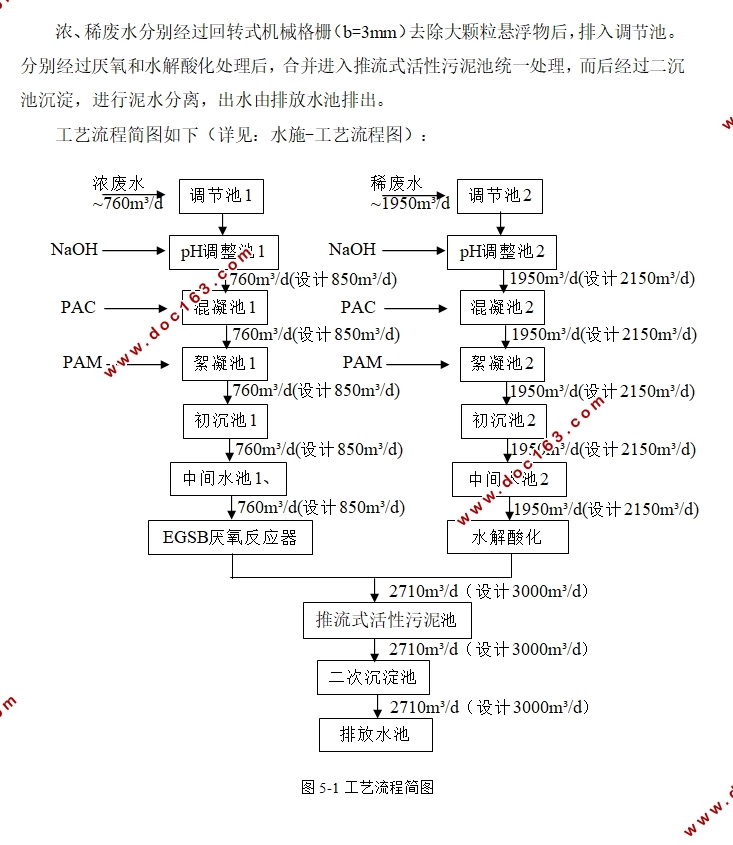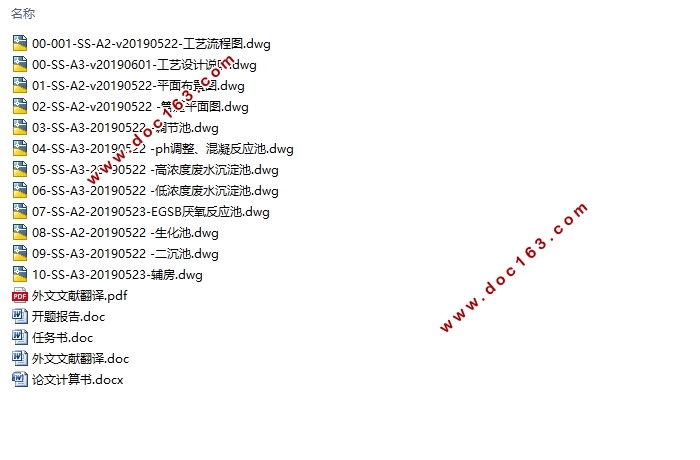东营市柠檬酸厂3000m3/d污水处理工程设计(含CAD图)

1.无需注册登录,支付后按照提示操作即可获取该资料.
2.资料以网页介绍的为准,下载后不会有水印.资料仅供学习参考之用.
密 惠 保
东营市柠檬酸厂3000m3/d污水处理工程设计(含CAD图)(任务书,开题报告,外文文献翻译,论文计算书14700字,CAD图12张)
摘 要
山东东营市柠檬酸厂,以薯干为原料,通过发酵工艺生产柠檬酸。其生产废水来源主要来自于发酵、过滤、洗糖废水,离子交换再生废水、浓缩冷凝水。废水主要由高浓度废水和低浓度废水两股组成。为配合区域整体规划设计,环保工程与主体工程同时设计、施工、运营、并体现“节能减排、循环利用”的绿色经济原则。
高浓度废水呈酸性,COD和BOD含量相比低浓度废水较高。两股废水的可生化性较好,适宜采用生化处理。考虑到两股废水COD值差异较大,厌氧处理对于高浓度有机物废水的高效处理性,选择对两股废水进行分质处理。
根据工艺比较选择,对于高浓度废水采用EGSB厌氧处理法,对于低浓度废水采用水解酸化法,提高可生化性。在后续的合并好氧反应中,进一步降解有机物。
经过反应,可以将COD浓度从2761mg/L,降至276.1mg/L。
在本设计中,对废水处理系统的构筑物进行了计算、布置和绘图,并对各个构筑物之间的管道系统进行了设计,对整个污水处理厂项目进行了运行成本和总投资的预算。
关键词:分质处理;EGSB;厌氧好氧反应 [来源:http://think58.com]
ABSTRACT
Shandong dongying citric acid plant, produce citric acid by fermentation process with the dried potato as raw material. Its production wastewater mainly come from the fermentation, filtration and sugar washing wastewater, ion-exchange regeneration wastewater and condensed water. The wastewater consists both high concentration wastewater and low concentration wastewater. In order to coordinate with the overall planning and design of the area, the environmental protection project and the main project are designed, constructed and operated at the same time. The green economy principle of “energy saving, emission reduction and recycling” is embodied.
The high concentration wastewater is acid. Comparing with the low concentration wastewater, its COD and BOD values are fairly high. The biodegradability of these two streams of wastewater are good. Therefore, they are suitable for biochemical treatment. Considering the difference of COD values between these two wastewater streams, much efficiency that can be achieved when choosing anaerobic treatment for high concentration wastewater. In conclude, we treat the two streams with different methods. [资料来源:http://www.THINK58.com]
According to the process of the comparison selection, EGSB anaerobic treatment is used for high concentration wastewater and hydrolytic acidification method is used for low concentration wastewater to improve its biodegradability. In the following aerobic reactions, further degradation of organic compounds can be achieved.
After the reaction, the COD value can be reduced from 2761mg/L to 276.1mg/L.
In this design, the structures of wastewater treatment systems have been designed, calculated, arranged and plotted. The piping system between structures have also been designed. The operation costs and total investment of this wastewater treatment plant have also been estimated.
Key words:Classification treatment; EGSB treatment; Anaerobic and Aerobic reactions
1.3设计规模
实际总废水量:
高浓度废水760m³/d ;
低浓度废水1950m³/d;
合计:Q=2710m³/d;
设计规模确定:
满足现阶段生产废水处理要求,同时,为企业扩大再生产废水量增加,适当留有一定余量,拟废水处理厂设计规模: [资料来源:http://think58.com]
高浓度废水760m³/d,设计按850m³/d;
低浓度废水1950m³/d,设计按2150m³/d;
考虑沉淀池表面负荷的限制及设备检修,设计运行时间22h,设计流量如下:
高浓度废水:设计流量:按38m³/h;
低浓度废水:设计流量:按98m³/d;
其余系统按照设计规模计算,设计运行时间24h,设计流量如下:
高浓度废水:设计流量:按36m³/h;
低浓度废水:设计流量:按90m³/d;
[资料来源:www.THINK58.com]





[资料来源:THINK58.com]

目 录
摘要 II
ABSTRACT III
第一章 项目概述 1
1.1 项目背景 1
1.2 生产排水及原水参数 1
1.3 设计规模 1
1.4 排放水质标准 2
第二章 设计原则、范围 3
2.1设计原则 3
2.2工程范围及内容 3
第三章 废水污染因子特征分析 4
3.1有机物 4
3.2 悬浮固体 4
3.3 pH值 4
3.4 NH3-N 4
3.5 无机盐 4
第四章 工艺比选及确认 5
4.1 分质/合并处理分析 5
4.2 物理分离 5
4.2.1 混凝沉淀 5
4.2.2 混凝过滤 5
4.2.3 混凝气浮 5
4.2.4 工艺比选 6
4.3 生化处理工艺分析 6
4.3.1 厌氧生物处理法 6
4.3.2 工艺比选 7
4.4 NH3-N 7
4.4.1 生物硝化 7
4.4.2 化学氧化 7
4.4.3 工艺比选 7
第五章 工艺流程 8
5.1 工艺流程 8
5.2 主要工艺单元描述 9
5.2.1 调节池 9
5.2.2 pH调整池/混凝池/絮凝池 9
5.2.3 初沉池 9
5.2.4 EGSB厌氧反应池 9
5.2.5 水解酸化池 10
5.2.6 推流式活性污泥池 10
5.2.7 二沉池 10
5.3 水流向描述 10
5.4 污泥处置描述 10
5.5 加药描述 11 [版权所有:http://think58.com]
5.6 气描述 11
第六章 单元工艺设计 12
6.1 高浓度废水预处理 12
6.1.1 调节池 12
6.1.2 pH调整池/混凝池/絮凝池 13
6.1.3 初沉池 15
6.1.4 中间水池 16
6.1.5 EGSB厌氧反应器 17
6.2 低浓度废水预处理 19
6.2.1 调节池 19
6.2.2 pH调整池/混凝池/絮凝池 19
6.2.3 初沉池 21
6.2.4 中间水池 22
6.2.5 升流式酸化反应器 23
6.3 合并处理 24
6.3.1 生物推流式活性污泥池 24
6.3.2 二沉池 27
6.3.2 排放水池 28
6.4 污泥处置 29
6.4.1 污泥池 29
6.4.2 污泥脱水区 29
6.5公用工程 30
6.5.1 风机房 30
6.5.2 控制值班/管理室 30
6.5.3 加药/储藏间 30
6.5.4 管理室 30
第七章 运营成本 31
7.1 用电负荷(a) 31
7.2 化学药剂消耗(b) 31
7.3 人工费用(c) 32
7.4 直接运行成本(d) 32
第八章 设备及土建预算 33
8.1主要工艺设备表 33
8.2构筑物工艺尺寸表 34
8.3总投资 35
第九章 图纸 36
总结 36
参考文献 38
致谢 39
[来源:http://think58.com]
